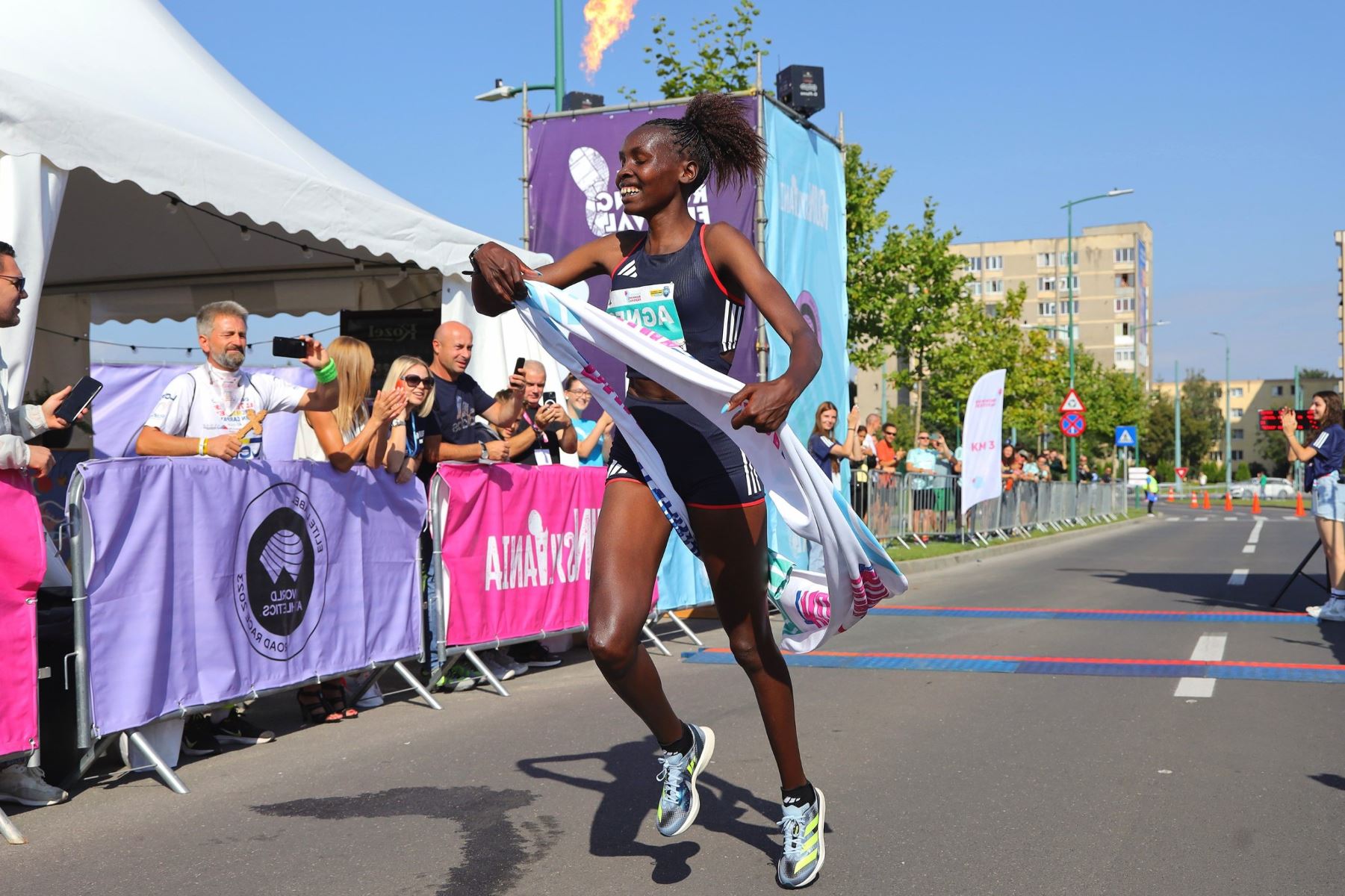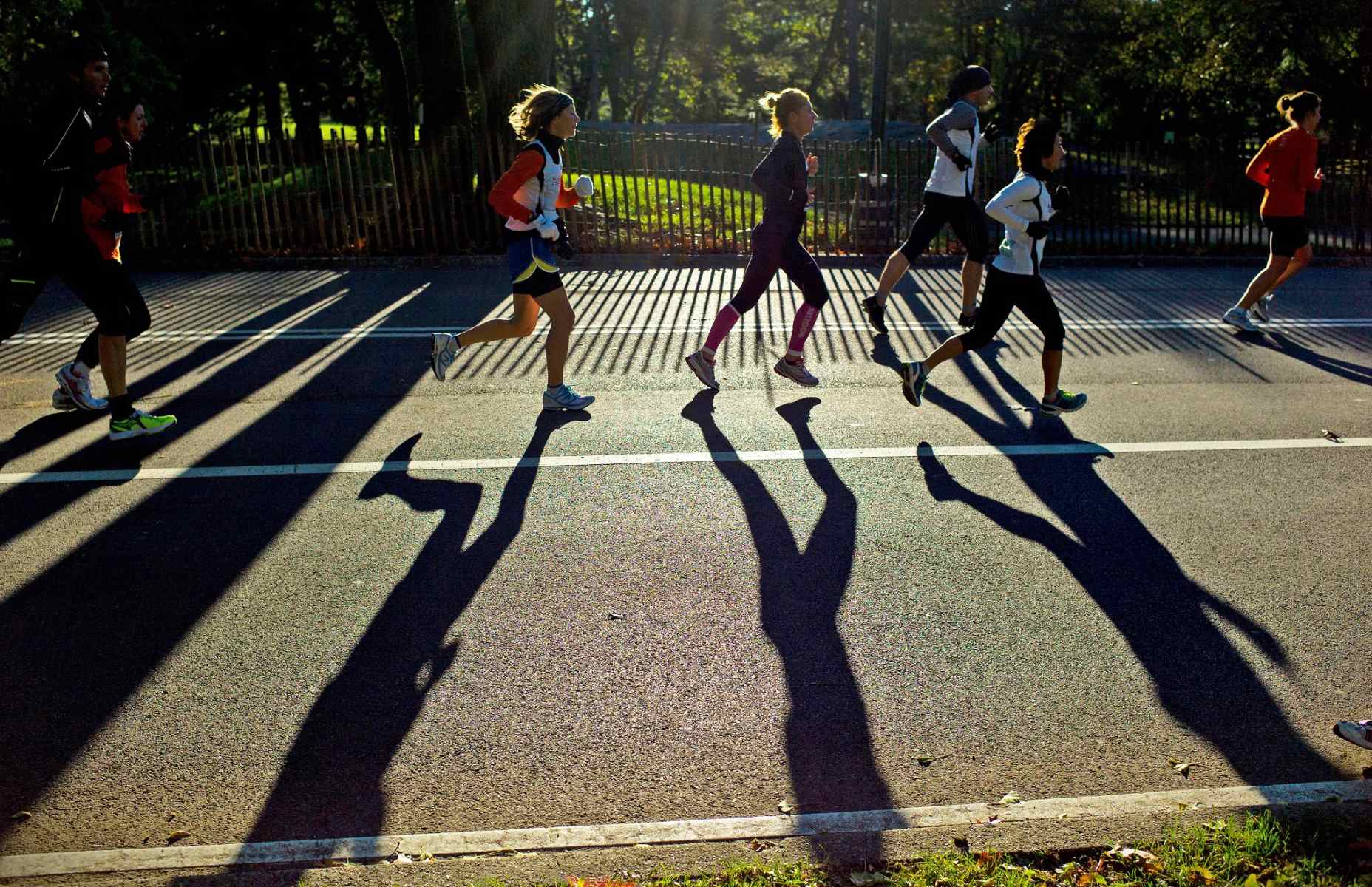Home>Training & Techniques>Training Plans>Increasing Your Running Distance: From 5k To 10k


Training Plans
Increasing Your Running Distance: From 5k To 10k
Published: March 1, 2024
Looking to increase your running distance from 5k to 10k? Explore effective training plans and tips to help you achieve your goal efficiently. Unlock your potential with expert guidance.
(Many of the links in this article redirect to a specific reviewed product. Your purchase of these products through affiliate links helps to generate commission for Therunningadvisor.com, at no extra cost. Learn more)
Table of Contents
Setting Your Goal
Setting a clear and achievable goal is the first step in transitioning from a 5k to a 10k runner. Your goal serves as the guiding force that propels you forward, providing motivation and a sense of purpose throughout your training journey.
When setting your goal, it's essential to make it specific and measurable. Instead of simply aiming to run a 10k, consider setting a target completion time or a specific race you want to participate in. This not only gives you a clear target to work towards but also allows you to track your progress effectively.
Additionally, consider the timeframe within which you aim to achieve your goal. Setting a realistic timeline is crucial to prevent overwhelming yourself with an overly ambitious goal or losing motivation due to a goal that feels too distant. By breaking down your goal into smaller milestones, you can celebrate your progress along the way, keeping your motivation levels high.
Moreover, it's important to align your goal with your personal aspirations and motivations. Whether it's improving your overall fitness, challenging yourself, or simply enjoying the thrill of participating in races, understanding the underlying reasons behind your goal can provide a powerful source of inspiration.
Lastly, ensure that your goal is attainable and relevant to your current fitness level. While aiming high is admirable, setting a goal that is beyond your capabilities can lead to frustration and potential injury. By assessing your current running abilities and gradually increasing your distance, you can set a goal that pushes your limits while remaining within the realm of achievability.
By setting a clear, measurable, and personally meaningful goal, you lay a solid foundation for your journey from a 5k to a 10k runner. This goal will serve as a constant reminder of your commitment and determination, propelling you forward with purpose and enthusiasm.
Building Endurance
Building endurance is a fundamental aspect of transitioning from a 5k to a 10k runner. Endurance, in the context of running, refers to the ability to sustain physical exertion over an extended period. As you embark on this journey, gradually increasing your running distance, it's crucial to focus on enhancing your endurance to meet the demands of a 10k race. Here's how you can effectively build endurance:
Consistent Training
Consistency is key when it comes to building endurance. Incorporating regular running sessions into your weekly routine allows your body to adapt and improve its aerobic capacity. Aim to run at least three to four times a week, gradually increasing both the duration and intensity of your runs. Consistent training not only strengthens your cardiovascular system but also conditions your muscles and joints for the increased demands of longer distances.
Long Runs
Integrating long runs into your training regimen is essential for building endurance. These runs, typically performed once a week, gradually extend your running distance, pushing your body to adapt to sustained physical effort. Start by adding an extra kilometer to your longest run each week, gradually progressing towards the 10k distance. Long runs not only physically prepare you for the 10k but also build mental resilience, teaching you to push through fatigue and discomfort.
Cross-Training
Incorporating cross-training activities such as cycling, swimming, or strength training can complement your running routine and enhance overall endurance. These activities engage different muscle groups, reduce the risk of overuse injuries, and improve cardiovascular fitness. Additionally, cross-training provides a break from the repetitive impact of running while maintaining your aerobic capacity.
Pace Variation
While building endurance, it's beneficial to incorporate pace variation into your runs. This includes mixing slower, steady-state runs with faster intervals. By varying your pace, you challenge your cardiovascular system, improve running economy, and enhance your body's ability to sustain effort over longer distances. Interval training, which involves alternating between periods of high-intensity running and active recovery, is particularly effective in boosting endurance.
Patience and Progression
Building endurance is a gradual process that requires patience and mindful progression. Avoid the temptation to increase your running distance too rapidly, as this can lead to overtraining and potential injury. Instead, focus on steady, incremental progress, allowing your body to adapt and strengthen gradually. Listen to your body, pay attention to signs of fatigue or overexertion, and adjust your training accordingly.
By incorporating these strategies into your training plan, you can effectively build endurance and prepare your body for the demands of a 10k race. Remember that building endurance is not only a physical endeavor but also a mental one. Stay committed, stay consistent, and embrace the journey as you progress towards achieving your goal of running a 10k.
Incorporating Interval Training
Incorporating interval training into your running regimen can significantly enhance your ability to transition from a 5k to a 10k runner. Interval training involves alternating between periods of high-intensity running and active recovery. This structured approach to training not only boosts cardiovascular fitness but also improves running economy, making it an invaluable tool for increasing your overall endurance and speed.
One of the key benefits of interval training is its ability to elevate your heart rate to near-maximum levels during the high-intensity intervals. This challenges your cardiovascular system, improving its efficiency and capacity to deliver oxygen to working muscles. As a result, your body becomes more adept at sustaining prolonged physical effort, a crucial aspect of successfully completing a 10k race.
Moreover, interval training enhances your body's ability to clear lactate, a byproduct of intense exercise that can lead to muscle fatigue. By repeatedly pushing your limits during high-intensity intervals, you train your body to process and remove lactate more effectively, delaying the onset of fatigue and allowing you to maintain a strong pace throughout the 10k race.
In addition to its physiological benefits, interval training also plays a pivotal role in improving running speed and overall performance. The high-intensity intervals challenge your anaerobic threshold, the point at which your body switches from aerobic to anaerobic energy production. By pushing this threshold higher through interval training, you can sustain faster paces for longer durations, a valuable asset when aiming to complete a 10k race within a specific time goal.
When incorporating interval training into your routine, it's essential to structure your workouts thoughtfully. Begin with a proper warm-up to prepare your body for the upcoming intensity. Then, alternate between periods of high-intensity running, such as sprinting or fast-paced intervals, and active recovery, which involves jogging or walking. The duration and intensity of both the high-intensity and recovery intervals can be tailored to your current fitness level and progressively adjusted as you advance in your training.
Furthermore, interval training can take various forms, offering flexibility and diversity in your workouts. Whether it's traditional track intervals, hill repeats, or fartlek training, incorporating a mix of interval styles can keep your training engaging and challenging while targeting different aspects of your running performance.
By integrating interval training into your training plan, you can elevate your endurance, speed, and overall race readiness as you progress from a 5k to a 10k runner. Embrace the intensity, stay consistent, and reap the rewards of this powerful training method as you work towards achieving your 10k running goal.
Proper Nutrition and Hydration
Proper nutrition and hydration play a pivotal role in supporting your journey from a 5k to a 10k runner. Fueling your body with the right nutrients and maintaining optimal hydration levels are essential for sustaining energy, enhancing performance, and promoting overall well-being throughout your training and race day. Here's a detailed look at how you can prioritize nutrition and hydration to optimize your running experience:
Balanced Diet
A balanced diet forms the foundation of effective nutrition for runners. Ensure that your meals consist of a variety of nutrient-dense foods, including lean proteins, complex carbohydrates, healthy fats, and a rich assortment of fruits and vegetables. These components provide the essential macronutrients and micronutrients necessary for energy production, muscle repair, and overall health. Incorporating whole grains, such as quinoa and brown rice, alongside lean sources of protein, like chicken and tofu, can support sustained energy levels and muscle recovery.
Pre-Run Fueling
Prior to your training runs and the 10k race, focus on consuming a pre-run meal that strikes a balance between providing energy and preventing gastrointestinal discomfort. Opt for easily digestible carbohydrates, such as bananas, oatmeal, or whole-grain toast, to fuel your muscles and top off your glycogen stores. Additionally, ensure that your pre-run meal includes a moderate amount of protein to support muscle maintenance and repair.
Hydration Strategies
Proper hydration is critical for maintaining performance and preventing dehydration-related issues during your runs. Develop a hydration strategy that involves regular water intake throughout the day, aiming to consume at least 8-10 glasses of water to stay adequately hydrated. Additionally, pay attention to your fluid intake before, during, and after your runs. Prior to longer training sessions and the 10k race, hydrate sufficiently in the hours leading up to the run, and consider consuming a sports drink containing electrolytes to replenish lost fluids and minerals during extended exercise.
Post-Run Recovery
After completing your training runs and the 10k race, prioritize post-run recovery nutrition to facilitate muscle repair and glycogen replenishment. Consume a combination of carbohydrates and protein within 30 minutes of finishing your run to kickstart the recovery process. This can include a protein shake, a banana with nut butter, or a turkey sandwich on whole-grain bread. Additionally, continue hydrating to replace fluid losses and aid in the recovery process.
Read more: Improve Your 5K Speed With This Workout
Race Day Nutrition
On the day of the 10k race, adhere to a familiar and well-tailored nutrition plan that aligns with your pre-race fueling and hydration strategies. Avoid experimenting with new foods or supplements on race day to minimize the risk of gastrointestinal distress. Instead, rely on the nutrition and hydration practices that have proven effective during your training runs, ensuring that you enter the race with a well-nourished and properly hydrated body.
By prioritizing proper nutrition and hydration, you can optimize your body's performance, support recovery, and enhance your overall running experience as you progress from a 5k to a 10k runner. Consistently fueling your body with the right nutrients and maintaining optimal hydration levels not only improves your physical capabilities but also contributes to your enjoyment and success as a 10k runner.
Gradual Progression
Gradual progression is the cornerstone of a successful transition from a 5k to a 10k runner. It involves a systematic and incremental increase in running distance, allowing your body to adapt and strengthen progressively. This approach not only minimizes the risk of overuse injuries but also fosters sustainable improvements in endurance and performance.
When implementing gradual progression, it's essential to strike a balance between challenging your body and avoiding excessive strain. Begin by assessing your current running capacity and identifying a starting point that aligns with your fitness level. Whether you're comfortable with a 5k distance or have been consistently running shorter distances, the key is to establish a baseline from which you can gradually expand your capabilities.
Once you've identified your starting point, aim to increase your weekly mileage by no more than 10%. This conservative approach allows your body to adapt to the incremental changes without being overwhelmed by sudden spikes in training volume. For instance, if your current weekly mileage is 15 kilometers, a reasonable progression would involve adding 1.5 kilometers to your total weekly distance.
In addition to increasing your overall weekly mileage, it's beneficial to incorporate longer runs into your training plan. These extended sessions, typically performed once a week, serve as a platform for pushing your boundaries and acclimating your body to sustained physical effort. By gradually extending the distance of your long runs, you build both physical and mental resilience, preparing yourself for the demands of a 10k race.
Furthermore, as you progress through your training, pay close attention to how your body responds to the increased mileage. Be mindful of any signs of fatigue, discomfort, or persistent soreness, as these may indicate the need for a more gradual approach. Listening to your body and adjusting your training accordingly is crucial for preventing overtraining and minimizing the risk of injury.
It's important to note that gradual progression extends beyond simply increasing running distance. It also encompasses the gradual incorporation of speed work, hill training, and other forms of running-specific workouts that contribute to overall performance enhancement. By gradually integrating these elements into your training regimen, you can further elevate your running capabilities and readiness for the 10k distance.
In essence, gradual progression is a patient and deliberate approach that respects the natural adaptation process of the body. By embracing this method, you can steadily expand your running horizons, build resilience, and ultimately achieve your goal of becoming a confident and capable 10k runner.
Rest and Recovery
Rest and recovery are integral components of a comprehensive training plan when transitioning from a 5k to a 10k runner. While the focus is often placed on the physical exertion of running, it is during periods of rest and recovery that the body undergoes essential adaptations, repairs, and growth. Here's a detailed look at the significance of rest and recovery in the context of your training journey:
Importance of Rest
Rest is not merely the absence of physical activity; it encompasses a deliberate period of reduced training intensity or complete cessation of exercise. During rest, the body undergoes crucial processes that contribute to overall performance improvement. This includes muscle repair, glycogen replenishment, and the restoration of energy stores. Moreover, adequate rest allows the central nervous system to recover, preventing mental fatigue and burnout.
Recovery Strategies
Incorporating active recovery strategies, such as gentle stretching, yoga, or low-impact cross-training activities, can promote blood circulation, alleviate muscle tension, and expedite the recovery process. Additionally, prioritizing quality sleep is paramount for overall recovery. During sleep, the body releases growth hormone, which aids in muscle repair and regeneration. Aim for 7-9 hours of uninterrupted sleep each night to support your training efforts effectively.
Listen to Your Body
Understanding the cues and signals from your body is essential in determining the need for rest and recovery. Persistent muscle soreness, decreased performance, and feelings of constant fatigue are indicators that your body requires additional rest. Ignoring these signals can lead to overtraining, diminishing returns, and an increased risk of injury. By respecting your body's need for rest, you can optimize your training outcomes and long-term athletic development.
Incorporating Rest Days
Integrating scheduled rest days into your training plan is crucial for preventing overuse injuries and mental burnout. These designated rest days provide an opportunity for both physical and mental rejuvenation, allowing you to return to your training sessions with renewed energy and focus. Embrace rest days as an essential part of your training journey, recognizing their role in sustaining long-term progress and well-being.
Balancing Training and Recovery
Achieving a harmonious balance between training and recovery is key to maximizing your running potential. While consistent training is vital for improvement, it is the integration of strategic rest and recovery periods that allows your body to adapt, grow stronger, and ultimately thrive as a 10k runner. By honoring the rest and recovery process, you set the stage for sustained progress and a fulfilling running experience.
In summary, rest and recovery are not passive elements of your training plan; they are active contributors to your overall growth and success as a 10k runner. Embrace rest and recovery as essential pillars of your journey, recognizing their transformative impact on your physical, mental, and emotional well-being.
Read more: Mastering The Art Of Running A Flawless 10K
Mental Preparation
Mental preparation is a critical aspect of transitioning from a 5k to a 10k runner. While physical training is essential, the mental fortitude and resilience required to conquer the challenges of a longer distance cannot be overlooked. Here's a detailed exploration of the significance of mental preparation and strategies to cultivate a strong and resilient mindset for your 10k journey.
Visualizing Success
Visualization is a powerful mental tool that can significantly impact your performance as a runner. Take time to visualize yourself successfully completing a 10k race, envisioning the course, the cheering crowd, and the exhilaration of crossing the finish line. By repeatedly visualizing positive outcomes, you condition your mind to embrace the challenge with confidence and determination.
Goal Setting and Positive Affirmations
Setting specific and achievable goals for your 10k journey provides a sense of purpose and direction. Additionally, incorporating positive affirmations into your daily routine can bolster your confidence and self-belief. Affirmations such as "I am strong and capable" or "I am prepared to conquer the 10k distance" can reinforce a positive mindset and counter self-doubt.
Embracing Discomfort and Challenges
Mental resilience is cultivated through embracing discomfort and challenges during training. Instead of shying away from the physical and mental strain of longer runs, view them as opportunities to strengthen your resolve and resilience. Embracing discomfort during training prepares you to confront and overcome obstacles during the 10k race.
Read more: Expert Tips For Running A Sub 20 5k
Mindfulness and Focus
Practicing mindfulness techniques, such as deep breathing and focused attention, can help calm pre-race nerves and enhance your ability to stay present during the race. By maintaining focus on each step and breath, you can prevent distractions and self-doubt from derailing your performance, allowing you to stay in the moment and perform at your best.
Overcoming Negative Self-Talk
Negative self-talk can undermine your confidence and performance. Identify and challenge negative thoughts that arise during training and racing, replacing them with positive and empowering self-talk. By reframing negative thoughts into constructive and motivating dialogue, you can bolster your mental resilience and fortitude.
Building Mental Toughness Through Training
Enduring the physical and mental challenges of training runs cultivates mental toughness. Embrace the discomfort, fatigue, and doubts that may arise during training as opportunities to strengthen your mental resilience. By persevering through tough training sessions, you build the mental fortitude necessary to tackle the 10k distance.
Seeking Support and Encouragement
Surround yourself with a supportive network of fellow runners, friends, or a running community. Sharing your aspirations and challenges with others can provide valuable encouragement and motivation. Additionally, drawing inspiration from the experiences and successes of others can bolster your confidence and belief in your own capabilities.
In essence, mental preparation is a foundational element of your journey from a 5k to a 10k runner. By cultivating a resilient and positive mindset, visualizing success, and embracing discomfort, you can fortify your mental strength and readiness for the challenges and triumphs that await you on your path to becoming a confident and accomplished 10k runner.
Avoiding Common Injuries
As you progress from a 5k to a 10k runner, safeguarding yourself against common running injuries becomes paramount. These injuries, often stemming from overuse, improper form, or inadequate recovery, can derail your training and hinder your progress. By proactively implementing injury prevention strategies, you can minimize the risk of setbacks and sustain your momentum towards achieving your 10k running goal.
Proper Warm-Up and Cool Down
Initiating your runs with a dynamic warm-up routine primes your muscles, tendons, and ligaments for the impending physical exertion, reducing the likelihood of strains and sprains. Incorporate dynamic stretches, leg swings, and light jogging to gradually elevate your heart rate and increase blood flow to the working muscles. Similarly, concluding your runs with a thorough cool-down, including static stretching and gentle mobility exercises, aids in muscle recovery and flexibility, mitigating post-run soreness and potential injuries.
Strength and Stability Training
Integrating strength and stability exercises into your training regimen fortifies the muscles and connective tissues essential for running. Targeting muscle groups such as the core, hips, glutes, and lower limbs through exercises like squats, lunges, planks, and resistance band work enhances overall stability and reduces the impact of repetitive stress on vulnerable areas. Additionally, incorporating balance and proprioception drills can improve coordination and prevent missteps that may lead to injuries.
Adequate Rest and Recovery
Allowing your body sufficient time to recover between runs is crucial for injury prevention. Overtraining and insufficient rest can lead to fatigue, compromised form, and heightened injury risk. Integrate rest days into your training schedule, providing your body with the opportunity to repair and adapt to the physical demands of running. Embrace recovery strategies such as foam rolling, massage, and adequate sleep to support the body's healing processes and minimize the accumulation of training-related stress.
Proper Footwear and Running Surface Awareness
Investing in appropriate running shoes that suit your foot type and running gait is essential for mitigating the risk of foot, ankle, and lower limb injuries. Regularly assess the condition of your shoes and replace them as needed to maintain optimal support and cushioning. Furthermore, being mindful of the running surfaces you frequent can aid in injury prevention. Varying your running routes and avoiding consistently hard or uneven surfaces can reduce the impact on your joints and lower the risk of overuse injuries.
Listen to Your Body
Attentively tuning into your body's signals and addressing any signs of discomfort or pain promptly is crucial for injury prevention. Ignoring persistent aches or discomfort can exacerbate underlying issues and lead to more severe injuries. If you experience recurring pain or discomfort, consider seeking guidance from a healthcare professional or a qualified running coach to address potential concerns and prevent injury escalation.
By prioritizing injury prevention strategies, you can safeguard your running journey from the setbacks of common running injuries. Embrace a holistic approach that encompasses proper warm-up and cool down routines, strength and stability training, adequate rest and recovery, mindful footwear selection, and proactive attention to your body's signals. Through these proactive measures, you can sustain your training consistency and progress towards becoming a resilient and injury-resistant 10k runner.
Finding a Training Plan
Embarking on the journey from a 5k to a 10k runner necessitates a well-structured and progressive training plan tailored to your current fitness level and future aspirations. Finding a suitable training plan is pivotal in providing the framework, guidance, and progression necessary to prepare your body and mind for the 10k distance.
When seeking a training plan, consider factors such as your running experience, weekly time availability for training, and any specific goals you aim to achieve within the 10k race. Whether you opt for a pre-designed training program, enlist the expertise of a running coach, or craft a personalized plan, the key lies in aligning the plan with your individual needs and capabilities.
Pre-designed training plans, readily available in various formats such as online resources, running magazines, or running apps, offer a convenient starting point for many runners. These plans often cater to different experience levels and goal times, providing a structured outline of weekly mileage, long runs, speed workouts, and rest days. When selecting a pre-designed plan, ensure that it aligns with your current fitness level and allows for gradual progression to prevent overexertion and potential injury.
For those seeking a more personalized and adaptable approach, enlisting the guidance of a running coach can provide invaluable insights and tailored training regimens. A running coach can assess your running form, strengths, and areas for improvement, crafting a plan that addresses your specific needs and aligns with your lifestyle and schedule. Additionally, a coach can offer ongoing support, performance feedback, and adjustments to the training plan based on your progress and feedback.
Crafting a personalized training plan, whether independently or with the guidance of a coach, allows for a highly tailored approach that considers your unique strengths, weaknesses, and preferences. This method involves understanding fundamental training principles, such as building endurance, incorporating speed work, and balancing rest and recovery. By customizing your plan, you can integrate elements that resonate with your running style and goals, fostering a sense of ownership and commitment to your training journey.
Ultimately, the ideal training plan is one that resonates with your individual needs, aligns with your current capabilities, and propels you towards your 10k running goal with purpose and confidence. Whether you opt for a pre-designed plan, seek the expertise of a coach, or craft a personalized regimen, the training plan you choose should serve as a supportive and empowering framework that nurtures your growth and progression as a 10k runner.
Staying Motivated
Maintaining motivation throughout your journey from a 5k to a 10k runner is essential for consistent progress and a fulfilling running experience. As you tackle longer distances and more rigorous training, staying motivated can be a determining factor in your success. Here are some effective strategies to keep your motivation levels high:
Read more: 5K Run: Boost Your Endurance And Fitness
Set Milestones and Celebrate Progress
Breaking down your 10k goal into smaller milestones allows you to celebrate achievements along the way. Whether it's completing a longer training run, achieving a personal best in a 5k race, or conquering a challenging hill workout, acknowledging and celebrating these milestones reinforces your progress and fuels your motivation to continue.
Embrace Variety in Training
Introducing variety into your training regimen can prevent monotony and rekindle your enthusiasm for running. Incorporate diverse running routes, explore scenic trails, or participate in fun and engaging running events. Additionally, cross-training activities such as cycling, swimming, or yoga can add a refreshing dimension to your overall fitness routine, keeping your motivation levels high.
Cultivate a Supportive Network
Surrounding yourself with a supportive network of fellow runners, friends, or a running community can provide invaluable encouragement and motivation. Sharing your running experiences, challenges, and triumphs with like-minded individuals fosters a sense of camaraderie and accountability, inspiring you to stay committed to your 10k goal.
Visualize Race Day Success
Visualizing yourself crossing the finish line of a 10k race, feeling strong, accomplished, and exhilarated, can serve as a powerful source of motivation. Embrace the mental imagery of your race day success during challenging training sessions, drawing inspiration from the anticipation of achieving your goal.
Reflect on Your Why
Reconnecting with the underlying reasons behind your aspiration to become a 10k runner can reignite your motivation. Whether it's improving your overall fitness, setting a positive example for others, or simply experiencing the joy of running, reflecting on your intrinsic motivations can reinforce your commitment and determination.
Seek Inspiration from Others
Drawing inspiration from the achievements and stories of other runners, whether elite athletes or fellow enthusiasts, can fuel your motivation. Engage with running communities, read inspiring running literature, or follow the journeys of renowned runners to glean insights and motivation that resonate with your own aspirations.
By integrating these strategies into your training and mindset, you can sustain high levels of motivation as you progress from a 5k to a 10k runner. Embrace the journey, stay adaptable, and leverage these motivational tools to propel yourself towards achieving your 10k running goal with unwavering determination and enthusiasm.






